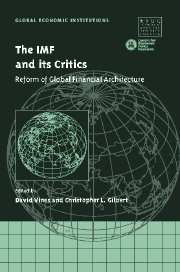Book contents
- Frontmatter
- Contents
- List of figures
- List of tables
- List of contributors
- Acknowledgements
- Introduction
- 1 The IMF and international financial architecture: solvency and liquidity
- 2 Progress towards greater international financial stability
- 3 International coordination of macroeconomic policies: still alive in the new millennium?
- 4 The Report of the International Financial Institution Advisory Commission: comments on the critics
- 5 Reforming the global financial architecture: just tinkering around the edges?
- 6 The IMF and capital account liberalisation
- 7 How should the IMF view capital controls?
- 8 The resolution of international financial crises: an alternative framework
- 9 Whose programme is it? Policy ownership and conditional lending
- 10 The IMF and East Asia: a changing regional financial architecture
- 11 The role of the IMF in developing countries
- 12 Argentina and the Fund: anatomy of a policy failure
- 13 Countries in payments' difficulties: what can the IMF do?
- 14 Accountability, governance and the reform of the IMF
- 15 The IMF at the start of the twenty-first century: what has been learned? On which values can we establish a humanised globalisation?
- Index
- References
10 - The IMF and East Asia: a changing regional financial architecture
Published online by Cambridge University Press: 04 December 2009
- Frontmatter
- Contents
- List of figures
- List of tables
- List of contributors
- Acknowledgements
- Introduction
- 1 The IMF and international financial architecture: solvency and liquidity
- 2 Progress towards greater international financial stability
- 3 International coordination of macroeconomic policies: still alive in the new millennium?
- 4 The Report of the International Financial Institution Advisory Commission: comments on the critics
- 5 Reforming the global financial architecture: just tinkering around the edges?
- 6 The IMF and capital account liberalisation
- 7 How should the IMF view capital controls?
- 8 The resolution of international financial crises: an alternative framework
- 9 Whose programme is it? Policy ownership and conditional lending
- 10 The IMF and East Asia: a changing regional financial architecture
- 11 The role of the IMF in developing countries
- 12 Argentina and the Fund: anatomy of a policy failure
- 13 Countries in payments' difficulties: what can the IMF do?
- 14 Accountability, governance and the reform of the IMF
- 15 The IMF at the start of the twenty-first century: what has been learned? On which values can we establish a humanised globalisation?
- Index
- References
Summary
Introduction
The financial crises of 1997 and 1998 have had a profound effect on East Asia's view of international financial and monetary arrangements, including the role of the International Monetary Fund (IMF) in international policy dialogue and financial cooperation. There has been a tectonic shift in the policy landscape of the region. While there are differences between and within countries, no longer is East Asia content to rely almost exclusively on global forums, mechanisms and institutions; it now wants to develop a complementary regional structure. The process of developing a regional economic and financial architecture may be in its early stages but the political and policy dynamics under way make it irreversible.
There are many elements to the expansion of regional arrangements – ranging from strengthened policy dialogue, greater financial cooperation, deeper economic and trade integration and even common currency arrangements. Much of the content of the evolving debate and policy on regional financial arrangements is tied directly to the region's discontent with the IMF and its concomitant, disillusion with the way the United States dealt with the financial crisis in East Asia. It is also motivated by a profound sense that deep economic and financial integration in East Asia can be of substantial benefit, both nationally and internationally, to countries in the region. At the same time, the European experience is seen as compelling.
- Type
- Chapter
- Information
- The IMF and its CriticsReform of Global Financial Architecture, pp. 254 - 287Publisher: Cambridge University PressPrint publication year: 2004
References
- 3
- Cited by



